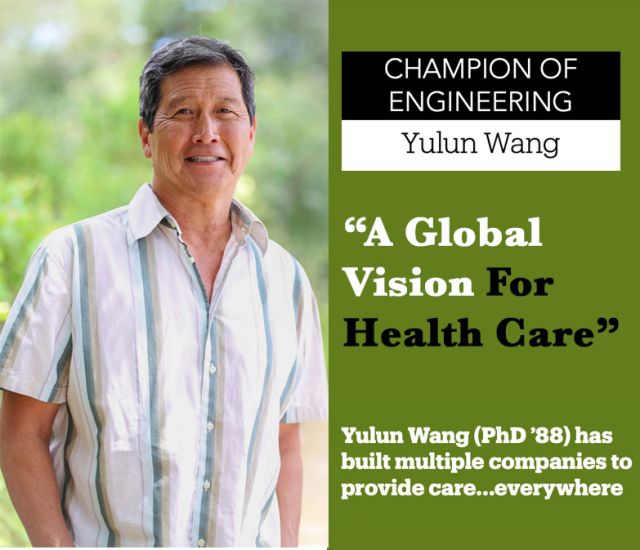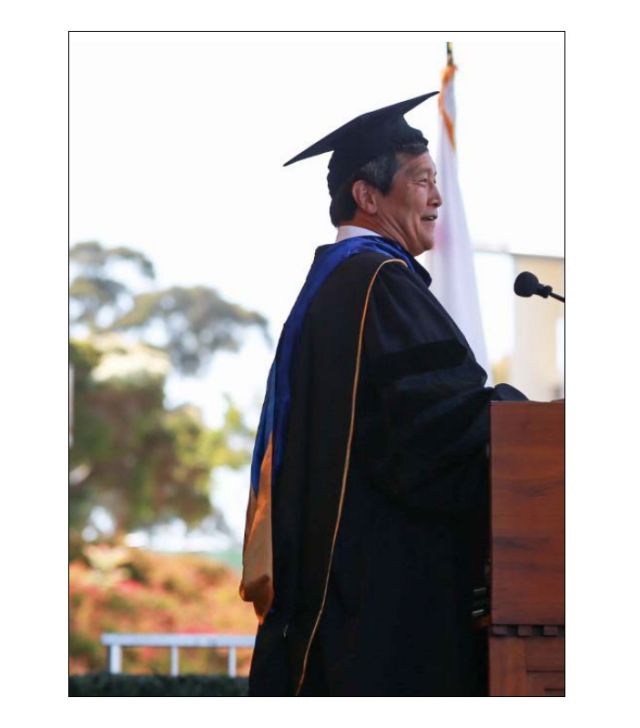
Yulun Wang (PhD ’88) – "A Global Vision for Health Care"
Wang has built multiple companies to provide care…everywhere
From Convergence (Summer 2024): the magazine of engineering at the sciences at UC Santa Barbara (pgs 28-29)
Remote surgery, telemedicine in all its forms, even international remote medical consultations and remotely supported surgeries in underserved areas of the world — Yulun Wang has played an instrumental role in making all of these important, often-life-saving, services possible.
After earning his BS, MS, and PhD (‘88) in electrical and computer engineering at UC Santa Barbara — he wrote his dissertation on a novel high-performance computer for advanced robot control — Wang started founding companies to serve people’s medical needs. At his first, he invented the voice controlled robotic arm, making Computer Motion, founded in 1990, the first company in the world to bring an FDA-approved surgical robot to market. Computer Motion IPO’d in 1997 and then merged with Intuitive Surgical in 2003. He founded InTouch Health in 2003, becoming a pioneer in remote medical consultation. The company sold to Teledoc for $1.1 billion in 2020. In 2017, he formed the nonprofit World Telehealth Initiative (WTI), leveraging a global network of tens of thousands of physicians to sustainably provide medical expertise to the world’s most vulnerable and underserved communities. His latest company, Sovato, is focused on using remote telesurgery to address the extreme shortage of surgeons in many parts of the U.S. and the world. Convergence spoke with him in May.
Convergence: Did entrepreneurship come naturally to you?
Yulun Wang: After completing my PhD, I had to decide between going into academics or industry. I decided that I wanted to build products as opposed to publishing papers. I became an entrepreneur because I wanted to build my own products rather than working on other people’s ideas. I can’t say entrepreneurship came naturally, as I’ve learned thousands of lessons along the way.
C: What is some key advice you think aspiring entrepreneurs should know but might not know?
YW: I always say to aspiring entrepreneurs that one can be at the leading edge of a new technology at a young age, but you can only acquire business skills through years of doing business. So, my advice is to find some older, experienced mentors who can help them on their journey.
"The first six months, people were not willing to invest. But if you keep going, eventually you’ll find the person who says, ‘Wow, that’s great technology. I’ve been looking for something like that, and I’d like to support it.’ Just don’t give up"
C: What have been one or two of the most valuable lessons you’ve learned in overcoming challenges as an entrepreneur?
YW: First, perseverance and patience are necessary qualities for an entrepreneur. Second, enjoy the journey, as opposed to being fixated on the destination; that is easier said than done. Finally, know that there will surely be twists and turns along the way.
C: What were your biggest takeaways from your time at UCSB, aside from the knowledge and expertise you gained?
YW: I think the most important benefit of education is not only gaining knowledge but rather, learning how to think and how to explore. It’s about how curious you are about new ideas. I’ve now come to appreciate the fact that, usually, seventy to eighty percent of an intellectual pursuit lies in figuring out what the right problem is and framing it, as opposed to finding the solution — so, asking the right question. I have a phrase I use all the time that relates to an important specific skill set, which is creating order out of chaos. That, I find, is a very important skill set that applies not only to engineering, but to life in general.

C: Tell us a little about InTouch, your company that launched the world’s first medical robot, which conducted the first telesurgery.
YW: After Computer Motion merged with Intuitive Surgical in 2003, I started InTouch Health. In 2001, while still at Computer Motion, I led a project in which a surgeon in New York City operated on a patient in France. That was the first telesurgery. The world wasn’t ready for remote surgery in 2003, but it did seem ready for telemedicine, which is enabling a clinician to consult with a patient at a distance. That was the premise for InTouch. We built a robot that could move through the hospital the way a doctor does for patient rounds. It would go room to room and, with a bedside assistant, allow the remote doctor to see his or her patients throughout the day. We really found our market in taking care of stroke patients. At the time, stroke was the third-leading cause of death [it now ranks fifth] and the leading cause of long-term disability. The main reason was that you couldn’t get a stroke neurologist to the patient’s bedside fast enough, and with strokes, they say “Time is brain,” because during a stroke, up to 1.5 million brain cells die every minute in an untreated patient. Using telemedicine, we could get the remote stroke neurologist there fast to assess the patient and figure out the right treatment quickly. Today, InTouch, which is now a part of Teladoc Health, facilitates over two hundred thousand stroke assessments a year. Based on our periodic surveys of nurses who are helping patients, we estimate that about ten percent of those stroke interventions are life-saving — that’s twenty thousand lives per year — and that roughly fifty percent of interventions reduce long-term negative outcomes, improving the outlook for another hundred thousand people per year.
C: You say that one of the most important elements of the World Telehealth Initiative is that the model is scalable. What makes it so?
YW: There are two big innovations we’re bringing forward. One is telemedicine, which we’ve talked about. The other is that we’re building a matching platform that takes into account multiple factors, such as medical expertise, time zones, provider availability, languages, existing relationships, diaspora, and so on, in order to connect the need to the provider. That is what is enabling us to scale while providing this capability at very little cost.
C: You’ve talked about breaking a career into three phases: survival (the beginning), success (through middle career) and significance. You seem to have moved into the last phase. Can you tell us something about that?
YW: In the significance phase, the focus is not about monetary gain anymore. Hopefully, you’ve got that kind of tucked away, and you can focus solely on how you think you can do good. For me, personally, I’ve mapped that into three main areas: I have the World Telehealth Initiative, a nonprofit that I work on a fair amount. I feel a tremendous debt of gratitude to, and affinity for, UCSB. I was educated there, and I think education is foundational for people being able to reach the significance phase. I have been connected to UCSB ever since. And I’m on the board of Cottage Hospital, so that’s on the healthcare side. Those are the things that I keep putting energy into. It’s nice, and necessary, for people to donate money to various causes, but I’ve tried to be more selective and to focus my effort in those three areas.
C: How does the UCSB component of that show up for you?
YW: I believe that you have to remember where you came from and who helped you along the way. UCSB was foundational in helping me to build what has been a very enjoyable and exciting career. I’ve been on the advisory board of both the Mechanical Engineering and Electrical and Computer Engineering Departments for a long, long time, and I speak there once or twice a year. I provide entrepreneurial advice. I’m contacted frequently by UCSB students, and even professors, who are interested in starting this or that, and I provide my input. I’ve also made financial contributions annually for decades. Again, rather than giving, say, one big gift, I prefer to maintain a long-term relationship, so I kind of couple my money and time together, and I intend to do that for the rest of my life.
C: What strikes you about the progress or change you’ve seen in the College of Engineering since you graduated in 1988?
YW: The College of Engineering has continually produced stellar graduates. I’ve hired well over one hundred of them over my career, and they do incredibly well. The other thing worth mentioning is the focus on interdisciplinary research. It really does shine through. I’ve interacted with people from all kinds of universities all over the country and around the world, and the collaboration that is part of the DNA and culture of the College of Engineering is unique. It’s real; it’s authentic, not just a bunch of talking points. I’m also what people might think of as a bioengineer, so I’m extremely interested to see how UCSB’s newest department, the new Bioengineering Department, is going to move forward.
From Convergence (Summer 2024): the magazine of engineering and the sciences at UC Santa Barbara